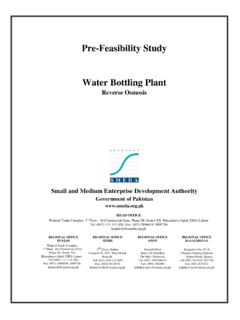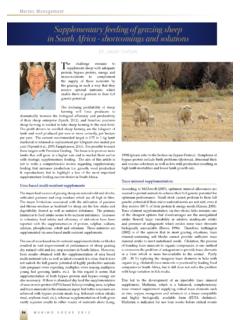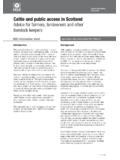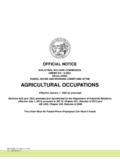Transcription of Pre-Feasibility Study - AMIS
1 Pre-Feasibility StudySShheeeeppFFaatttteenniinnggFFaarrm mSmall and Medium Enterprise Development AuthorityGovernment of OFFICE6th Floor, LDA Plaza, Egerton Road, : (042) 111-111-456, Fax: (042) , 6304926, OFFICE PUNJABREGIONAL OFFICE SINDHREGIONAL OFFICE NWFPREGIONAL OFFICE BALOCHISTAN8th Floor, LDA Plaza, Egerton Road, : (042) 111-111-456 Fax: (042) 6304926, Floor, BahriaComplex II, Khan Road, : (021) 111-111-456 Fax: (021) FloorState Life BuildingThe Mall, : (091) 9213046-47 Fax: (091) No. 15-AChaman Housing SchemeAirport Road, : (081) 2831623, 2831702 Fax: (081) 2008 Pre-Feasibility Study sheep Fattening Farm BAL-PREF-10/June, 2008 IIDISCLAIMERThe purpose and scope of this information memorandum is to introduce the subject matter and provide a general idea and information on the said area.
2 All the material included in this document is based on data/information gathered from various sources and is based on certain assumptions. Although, due care and diligence has been taken to compile this document, the contained information may vary due to any change in any of the concerned factors, and the actual results may differ substantially from the presented information. SMEDA does not assume any liability for any financial or other loss resulting from this memorandum in consequence of undertaking this activity. Therefore, the content of this memorandum should not be relied upon for making any decision, investment or otherwise.
3 The prospective user of this memorandum is encouraged to carry out his/her own due diligence and gather any information he/she considers necessary for making an informed decision. The content of the information memorandum does not bind SMEDA in any legal or other form. DOCUMENT CONTROLD ocument bySMEDA-BalochistanIssue DateJune, 2008 Issued bySMEDA-BalochistanPre- feasibility Study sheep Fattening Farm BAL-PREF-10/June, 2008 III1 Purpose of the 22 Project Brief .. Entry Timing .. Business Legal Status .. Product Mix .. Investment .. Project Parameters .. Location .. Success Factors/Practical Tips for Success .. Recommendations.
4 43 CURRENT INDUSTRY STRUCTURE .. Contribution to the Sector ..74 Market analysis .. Channels .. Market Requirements and farm management .. Criteria .. of Breeds Recommended for sheep Fattening: .. Management:.. Environment ..147 Human Resource Requirement ..158 Land and Building Requirement .. Mode ..169 Project Economics .. Cost .. Returns .. Financing ..16 Financial Analysis .. Cost .. Income Study sheep Fattening Farm BAL-PREF-10/June, Balance Cash Flow Assumptions .. Related Assumptions .. Flow Assumptions ..22 Pre-Feasibility Study sheep Fattening Farm BAL-PREF-10/June, 20081 Introduction to SMEDAThe Small and Medium Enterprise Development Authority (SMEDA) was established with the objective to provide fresh impetus to the economy through the launch of an aggressive SME support its inception in October 1998, SMEDA had adopted a sectoral SME development approach.
5 A few priority sectors were selected on the criterion of SME presence. In depth research was conducted and comprehensive development plans were formulated after identification of impediments and retardants. The all-encompassing sectoral development strategy involved recommending changes in the regulatory environment by taking into consideration other important aspects including financial aspects, niche marketing, technology upgradation and human resource has so far successfully formulated strategies for sectors including, fruits and vegetables, marble and granite, gems and jewelry, marine fisheries, leather and footwear, textiles, surgical instruments, urban transport and dairy.
6 Whereas the task of SME development at a broader scale still requires more coverage and enhanced reach in terms of SMEDA s areas of with the sectoral focus a broad spectrum of business development services is also offered to the SMEs by SMEDA. These services include identification of viable business opportunities for potential SME investors. In order to facilitate these investors, SMEDA provides business guidance through its help desk services as well as development of project specific documents. These documents consist of information required to make well-researched investment decisions. Pre-Feasibility studies and business plan development are some of the services provided to enhance the capacity of individual SMEs to exploit viable business opportunities in a better way.
7 This document is in the continuation of this effort to enable potential investors to make well-informed investment decisions. 1 For more information on services offered by SMEDA, please visit our website: Study sheep Fattening Farm BAL-PREF-10/June, 2008211 PPUURRPPOOSSEEOOFFTTHHEEDDOOCCUUMMEENNTT The objective of the Pre-Feasibility Study is primarily to facilitate potential entrepreneurs in project identification for investment. The project Pre-Feasibility may form the basis of an important investment decision and in order to serve this objective, the document/ Study covers various aspects of project concept development, start-up, and production, finance and business project is related to setting up a sheep fattening farm.
8 The document highlights all the marketing, management, and financial aspects required for the establishment and successful running of the farm will serve the purpose of fattening of sheep . The project can be established in parts of the country where sheep farming is already taking place. Livestock producers can obtain three to four flocks in one year depending upon their production and management techniques. The maximum Capacity of the farm is taken as 490 animals in one production cycle. The animals can be marketed in the local Piri as well as sold directly to the meat total project investment is Rs. million with a Project Internal Rate of Return (IRR) of 30% against the Capital Cost (WACC) of 16%.
9 The total project investment would be paid back in approximately for the livestock products has increased greatly in past two decades. The major cause in increase of demand of livestock products is continuing population growth, increase in per capita income, degree of urbanization and change in food consumption patterns. The continuously increasing demand has stretched the capacity of existing livestock production systems. Until recently the expansion of live stock food production was dependent on increased numbers of animals rather than higher carcass weight per animal. As the result of the higher demand, the livestock producers have to shift their focus to increase the use of new recourses rather then depending on the old production system of pastures.
10 The new production techniques would warrant stall/ supplementary feeding, non-conventional and economical feeding techniques and improved genetic material, the livestock farming can become a cost effective enterprise with its down stream positive effects in the farming community. Livestock producers can adopt non conventional feed preparation and feeding techniques like treatment of wheat/ rice straws and other crop residues with urea or ammonia, molasses bocks, silage making , concentrate mixtures with low cost formulae, feed lots, semi intensive farming and ewe flushing etc. such techniques have already been tested and demonstrated to the farmers under different projects.





